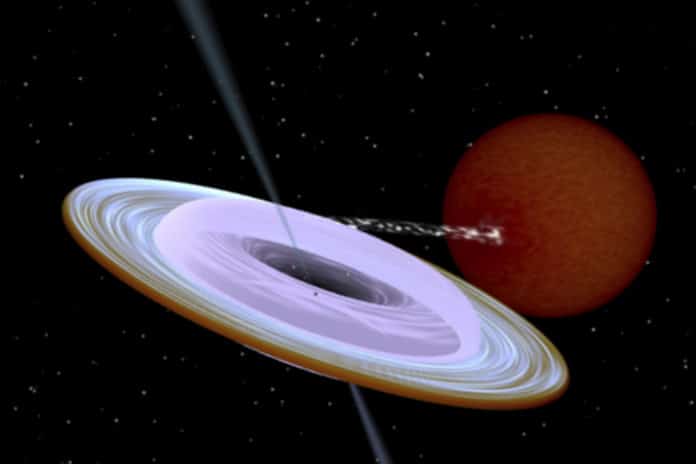Black holes are massive objects in the Universe. Like all other objects in Universe, black holes also spin, which is described by a conserved quantity called angular momentum, which accounts for both the speed of the rotating mass and its distance from the spin axis.
The observational signatures of black holes in binary x-ray systems depend on their masses, spins, accretion rate, and the misalignment angle between the black hole spin and the orbital angular momentum.
Scientists from the University of Turku recently determined the orbital axis of a black hole x-ray binary. They found a significant difference between the axis of rotation of a black hole and a binary system orbit.
Using optical polarimetric observations of the black hole x-ray binary MAXI J1820+070, scientists offered the first reliable measurement of the axis of rotation of a black hole in a binary system. Their measurement suggests that the axis of rotation of a black hole in a binary system is tilted more than 40 degrees relative to the axis of the stellar orbit.
This shows a huge difference between the axis of rotation of a black hole and a binary system orbit. The difference between the axes was more than 40 degrees.
Juri Poutanen, Professor of Astronomy at the University of Turku, said, “The expectation of alignment, to a large degree, does not hold for the bizarre objects such as black hole X-ray binaries. The black holes in these systems were formed due to a cosmic cataclysm – the collapse of a massive star.”
“Now we see the black hole dragging matter from the nearby, lighter companion star orbiting around it. We see bright optical and X-ray radiation as the last sigh of the infalling material, and also radio emission from the relativistic jets expelled from the system.”
In 2018, scientists detected relativistic ejections from the black hole X-ray binary. They then identified the direction by determining the rotation axis of the black hole itself. Once the source dimmed, scientists measured the orbit inclination. For this, they used spectroscopic techniques.
Juri Poutanen said, “To determine the 3D orientation of the orbit, one additionally needs to know the position angle of the system on the sky, meaning how the system is turned with respect to the direction to the North on the sky. This was measured using polarimetric techniques.”
“The results open interesting prospects towards studies of black hole formation and evolution of such systems, as such extreme misalignment is hard to get in many black hole formation and binary evolution scenarios.”
“The difference of more than 40 degrees between the orbital axis and the black hole spin was completely unexpected. Scientists have often assumed this difference to be very small when they have modeled the behavior of matter in a curved time-space around a black hole. The current models are already really complex, and now the new findings force us to add a new dimension to them.”
Alexandra Veledina, the Nordic Assistant Professor at Nordita, Nordic Institute for Theoretical Physics, said, “Polarization is a property of light, which is related to the predominant direction of electric field oscillations. This direction, defined as the polarization angle, is related to the symmetry axis of the system – in our case, the orbital axis. We were surprised to find that the Polarization in MAXI J1820+070 is largely offset from the direction of relativistic ejections.”
Journal Reference:
- Juri Poutanen et al. Black hole spin-orbit misalignment in the x-ray binary MAXI J1820+070. DOI: 10.1126/science.abl4679
